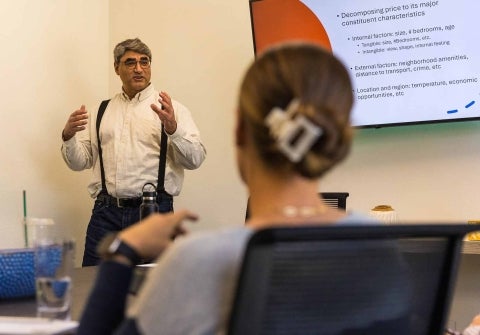Commercial Home Construction Alone Won’t Ease SLO County’s Housing Crisis, Says Cal Poly Finance Professor, Who Urges More ‘Targeted’ Residential Projects
Contact: Pat Pemberton
805-235-0555; ppembert@calpoly.edu
SAN LUIS OBISPO — While increased home construction is often cited as a solution to California’s affordability crisis, a Cal Poly finance professor says building more homes won’t solve the problem.
Instead, Hamed Ghoddusi, an associate professor at the Orfalea College of Business, said communities like San Luis Obispo need to pursue a concerted effort to build homes for specific types of workers, including educators and medical providers.
“There is a good reason for high house prices, which reflect the quality of local amenities and the willingness to pay for them,” said Ghoddusi, who recently researched the Central Coast housing market. “However, these prices are negatively affecting our area’s labor market by creating an imbalance or shortage in certain critical sectors.”

That imbalance could negatively impact the broader community in a variety of ways, he added.
“We already see that people in high-demand professions are leaving SLO to relocate to places that pay well and cost less to live,” he said. “Also, the ‘medical desert’ situation that is partly caused by high housing costs is forcing residents with specialized medical needs to leave the area to reside in counties with higher density of health-care providers. Some of those residents are critical members of the community that may not be easily replaced.”
The research, funded by the Economic Development Administration’s University Center, is part of a collaboration with CSU Chico, the grant leader, along with Cal Poly and Fresno State.
The median list price for homes home in San Luis Obispo exceeded $1.3 million this summer, according to the Realtors Association. That rising price is at least partly due to an influx of remote workers, local tech jobs and wealthy retirees, Ghoddusi said.
“The demand for those groups keeps the willingness to pay high and strong,” he said. “I believe with factors such as climate change, higher traffic and increased crime rates in larger cities, SLO may become even a more desired place to live and that may put further pressure on our local housing prices, similar to what Santa Barbara has experienced on a different scale.”
As a result, more construction would likely just add more expensive homes that are out of range for many locals — including a variety of needed professionals.
One example of a targeted project is evident at Cal Poly, where Cal Poly Partners, the university’s mission-driven nonprofit that for 85 years has enabled faculty research and supported Learn by Doing experiences for students, is currently building housing at a reduced cost for faculty and staff in an effort to recruit and retain qualified employees.
“We recognize that market-rate construction alone cannot address the housing challenges faced by our faculty and staff,” said Jim Dunning, associate executive director of Real Estate Development and Services with Cal Poly Partners.
The new construction supplements the Bella Montana housing development Cal Poly Partners currently provides for sale to faculty and staff, Dunning said.
“Our newest project, Vista Meadows, will feature 34 single family homes that further meet our goals to create a program that becomes increasingly attainable over time, ensuring that future generations of educators and staff can continue to live and work in the community they serve, even as broader housing market pressures continue to escalate.”
Targeted housing like that, Ghoddusi said, is different than affordable housing programs, such as the one used by the city of San Luis Obispo that requires most new residential and commercial development to contribute to affordable housing, either by constructing affordable housing units with the project or by paying an “in-lieu” fee to a city fund to help affordable housing development.
“Affordable housing works based on income limits, such as 30 percent or 80 percent of area median income,” he said. “The subjects of targeted housing typically earn just above the affordable housing income cap.”
While affordable housing programs are lottery based and represent a limited number of homes, Ghoddusi said, communities need to pursue multiple fronts to address the housing challenge.
“We need a portfolio of housing solutions, and this one is another program,” he said.
Ghodussi is a member of the Real Estate Initiative, a joint effort between the Orfalea College of Business and College of Architecture and Environmental Design to prepare Cal Poly students for real estate careers and provide relevant research.
“The Orfalea College of Business mission is to have a positive impact on business and society,” said Dean Damon Fleming. “Research like Hamed’s seeks solutions to challenges that can improve the quality of life in communities.”
While he sees targeted housing as one solution, Ghoddusi said the county still needs to produce expensive homes as well.
“While it may seem counterintuitive, it is part of the solution because this way you keep two demand groups separate and reduce the demand in the lower cost segment of the housing market,” he said. “However, we should also mind supply limitations. If the expensive housing projects compete and crowd out other potentially efficient housing projects, they will have a negative impact on targeted housing and work-force housing supply.”
# # #



